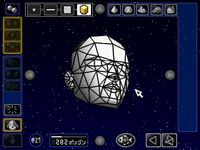Mario Artist: Polygon Studio: Difference between revisions
mNo edit summary |
mNo edit summary |
||
| Line 16: | Line 16: | ||
}} | }} | ||
[[File:MAPS Polygonedit.png|thumb|left|200px|''Mario Artist: Polygon Studio''; editing a face polygon.]] | [[File:MAPS Polygonedit.png|thumb|left|200px|''Mario Artist: Polygon Studio''; editing a face polygon.]] | ||
[[File:MAPS Microgame.png|thumb|left|200px|One of the microgames where the players should | [[File:MAPS Microgame.png|thumb|left|200px|One of the microgames where the players should click when a slice with their polygon on it will reach the arrow at the right.]] | ||
'''''Mario Artist: Polygon Studio''''' was the final game to be released in the ''[[Mario Artist]]'' series on the failing [[N64DD]]. There were four more planned but due to the failure of the system they remained unreleased. The game allows players to construct and render 3D polygons, then texture them, and paint them. The player can also import them into pre-made animations, much like the other titles in the series. Along with this the player can play [[microgames]] that include the player's polygon in the "Sound Bomber" mode. This is obviously the inspiration for the ''[[WarioWare]]'' series. What seem to be early versions of ''WarioWare'' microgames can be seen, including what is clearly [[Crazy Cars]]. They even level up as the player progresses. The microgames are also played on a tape recorder, providing further inspiration for ''WarioWare''. The game, at the very beginning, also has the push-up scene from ''[[Mario Paint]]''. | '''''Mario Artist: Polygon Studio''''' was the final game to be released in the ''[[Mario Artist]]'' series on the failing [[N64DD]]. There were four more planned but due to the failure of the system they remained unreleased. The game allows players to construct and render 3D polygons, then texture them, and paint them. The player can also import them into pre-made animations, much like the other titles in the series. Along with this the player can play [[microgames]] that include the player's polygon in the "Sound Bomber" mode. This is obviously the inspiration for the ''[[WarioWare]]'' series. What seem to be early versions of ''WarioWare'' microgames can be seen, including what is clearly [[Crazy Cars]]. They even level up as the player progresses. The microgames are also played on a tape recorder, providing further inspiration for ''WarioWare''. The game, at the very beginning, also has the push-up scene from ''[[Mario Paint]]''. | ||
<br clear=all> | <br clear=all> | ||
Revision as of 15:23, March 24, 2011
Mario Artist: Polygon Studio was the final game to be released in the Mario Artist series on the failing N64DD. There were four more planned but due to the failure of the system they remained unreleased. The game allows players to construct and render 3D polygons, then texture them, and paint them. The player can also import them into pre-made animations, much like the other titles in the series. Along with this the player can play microgames that include the player's polygon in the "Sound Bomber" mode. This is obviously the inspiration for the WarioWare series. What seem to be early versions of WarioWare microgames can be seen, including what is clearly Crazy Cars. They even level up as the player progresses. The microgames are also played on a tape recorder, providing further inspiration for WarioWare. The game, at the very beginning, also has the push-up scene from Mario Paint.
| Nintendo 64 games | ||
|---|---|---|
| Super Mario franchise | Super Mario 64 (1996) • Mario Kart 64 (1996) • Mario no Photopi (1998) • Mario Party (1998) • Mario Golf (1999) • Mario Artist: Paint Studio* (1999) • Mario Party 2 (1999) • Mario Artist: Talent Studio* (2000) • Mario Artist: Communication Kit* (2000) • Mario Tennis (2000) • Paper Mario (2000) • Mario Artist: Polygon Studio* (2000) • Mario Party 3 (2000) • Dr. Mario 64 (2001) | |
| Donkey Kong franchise | Diddy Kong Racing (1997) • Donkey Kong 64 (1999) | |
| Yoshi franchise | Yoshi's Story (1997) | |
| Crossovers | Super Smash Bros. (1999) | |

